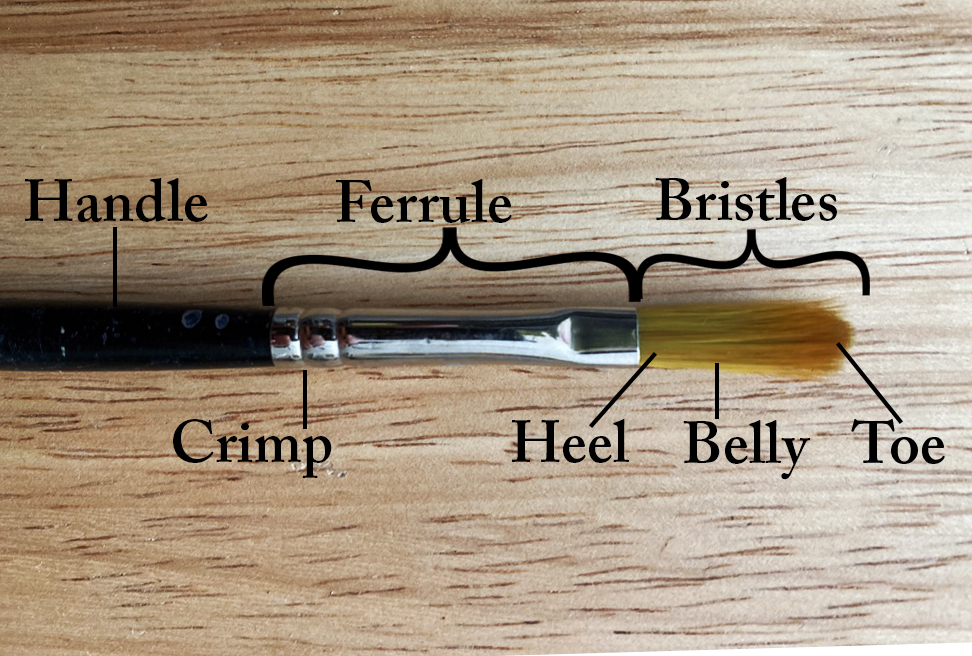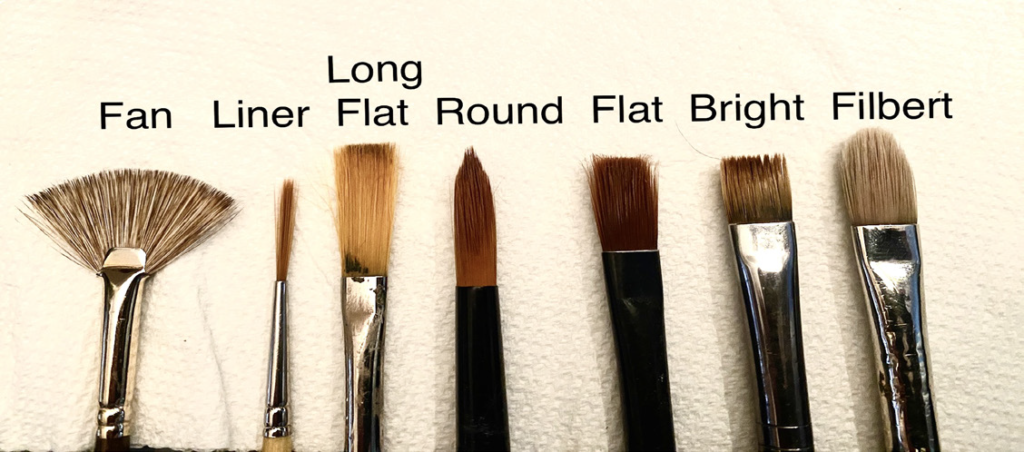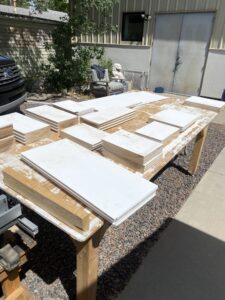If you’re an aspiring oil painter or a seasoned artist looking to elevate your craft, you’re in the right place. Today, we’re diving deep into the world of oil painting brushes. Brushes are your trusted companions on the canvas, and understanding their nuances can help you create true masterpieces. So, let’s embark on this creative journey together!
Unveiling the Brush: Parts and Materials
(I might include affiliate links in my posts! If you make a purchase through one of these links, it won’t cost you anything extra. You pay the same amount, but I earn a modest commission that supports the maintenance of this platform. Your support is greatly appreciated!)
Before we delve into the fascinating world of brushes, let’s get to know their anatomy and the materials that bring them to life.
The Anatomy of a Brush
A typical paintbrush has three main parts:
1. Bristles: These are the hair-like structures at the business end of the brush. Bristles can be natural or synthetic and come in various shapes and sizes, more on this below. The bristles are subdivided into three parts, the heel, the belly, and the toe.
2. Ferrule: The ferrule is the metal part that connects the bristles to the handle. It’s like the brush’s backbone, ensuring everything stays together.
3. Handle: The handle is the part you hold. It can be made of wood, acrylic, or other materials, providing balance and control.

Materials of the Trade
Types of Brushes
Now, let’s explore some of the different types of brushes you’ll encounter:
1. Round Brushes:
– Use: Great for detail work, outlines, and intricate areas.
– Shape: Round with a pointed tip.
2. Flat Brushes:
– Use: Ideal for bold strokes, washes, and covering larger areas. Can also achieve very thin lines if turned 90°.
– Shape: Flat with squared-off bristles.
3. Filbert Brushes:
– Use: Perfect for blending, soft edges, and creating curved strokes.
– Shape: Flat with rounded edges.
4. Fan Brushes:
– Use: Excellent for creating texture, blending, and feathering.
– Shape: Wide and flat, shaped like a fan.
5. Liner Brushes:
– Use: Designed for fine lines, calligraphy, and intricate details.
– Shape: Long and thin with fine, pointed bristles.
6. Mop Brushes:
– Use: Ideal for softening edges, washes, and applying thin glazes.
– Shape: Thick and round, like a mop head.
7. Egbert:
-Ideal for creating long, flowing strokes with soft edges.
-Shape: filbert with extra long, flat bristles that taper to a point.

Long vs Short Handles
The choice between long and short handle oil painting brushes primarily depends on the artist’s personal preference and the specific techniques they use. Here’s a breakdown of the differences and typical uses for each:
Long Handle Brushes:

Extended Reach: Long handle brushes are typically longer, allowing artists to hold them at a greater distance from the canvas. This extended reach is useful when you’re working on a large canvas or need to maintain a certain distance from your work for perspective or gestural painting.
Standing Easel: They are ideal for artists working at an upright easel, where the canvas is at chest or eye level. The longer handle ensures you can paint comfortably without leaning over too much.
Short Handle Brushes:
Control and Detail: Short handle brushes are generally shorter, allowing for more precise control and detailed work. They are often used for fine details, small canvases, or when the artist wants to work up close to the canvas.
Tabletop Work: Artists who prefer to work on a table or flat surface, rather than an upright easel, may find short handle brushes more comfortable.
Ultimately, the choice between long and short handle brushes can also be influenced by an artist’s individual painting style and comfort. Some artists may use both types in their work, depending on the specific needs of a painting. It’s a matter of personal preference and what works best for your particular painting technique and style.
Bristles or synthetic
Bristle Brushes:
1. Material: Bristle brushes are made from natural animal hairs, typically from hogs or boars. These hairs are strong and durable, making them suitable for oil paints.
2. Texture: Bristle brushes have a coarser texture compared to synthetic brushes. This texture can create visible brushstrokes and add texture to your paintings, making them ideal for expressive and textured work.
3. Absorbency: Natural bristles have a higher paint-carrying capacity. They can hold a substantial amount of paint, allowing you to cover larger areas without frequent reloading.
4. Stiffness: Bristle brushes tend to be stiffer, which makes them excellent for working with heavy body oil paints and applying paint with more force.
5. Durability: Bristle brushes are durable and can withstand the rigors of oil painting. With proper care, they can last a long time.
6. Use Cases: Bristle brushes are often used for bold strokes, impasto techniques (thickly applying paint), and expressive work. They are well-suited for artists who enjoy visible brushwork and texture in their paintings.
Synthetic Brushes:
1. Material: Synthetic brushes are made from man-made materials such as nylon or polyester. They are not natural animal hairs.
2. Texture: These brushes have a smoother texture compared to bristle brushes. This results in less visible brushwork and a smoother finish in paintings.
3. Absorbency: Synthetic brushes may have lower paint-carrying capacity compared to natural bristles. They can require more frequent reloading when covering large areas.
4. Stiffness: They can vary in stiffness depending on their intended use. Some synthetic brushes are designed to mimic the stiffness of natural bristle brushes, while others are softer and more flexible.
5. Durability: Synthetic brushes are often more durable in the sense that they are less likely to become damaged over time, even with exposure to solvents used in oil painting.
6. Use Cases: These brushes are versatile and can be used for various painting techniques. They are suitable for artists who prefer smoother, more controlled brushwork and may work well for detailed and precise work.
The choice between bristle and synthetic oil painting brushes depends on your artistic preferences and the techniques you wish to employ. Bristle brushes are known for their texture, durability, and suitability for bold strokes, while synthetic brushes offer smoother finishes and versatility. Many artists use a combination of both types of brushes to achieve their desired effects in their oil paintings.
Watercolor brushes for oil paints
Now, here’s a question that often arises: Can you use watercolor brushes for oil painting? Well, the short answer is yes, but there are some important considerations.
Watercolor brushes are usually made with softer bristles and may not stand up to the thicker consistency of oil paints. However, if you’re aiming for a specific effect or working on a smaller scale, using watercolor brushes with oils can work beautifully. Just remember to clean them thoroughly after each use.
Choosing the Perfect Brush: Brands
Finally, let’s talk about some of the best brands known for their quality oil painting brushes:
Rosemary & Co: Known for their handmade brushes, they’re a favorite among professional artists.
da Vinci: Offering an impressive selection of both natural and synthetic brushes, they’re celebrated for their craftsmanship.
Trekell: endorsed by many professional artists and painters. These brushes are known for their reliability and consistent performance. And taking into eco-friendly initiatives.
Trekell legion bristle brushes
Robert Simmons: these high quality brushes are often praised for their affordability making them accessible to artists of various skill levels and budgets.
Robert Simmons Signet brush pack
Robert Simmons Signet brush – 6 flat
Robert Simmons Signet brush – 10 flat
Robert Simmons Signet brush – 4 round
Robert Simmons Signet brush – 8 round
Winsor & Newton: A venerable name in the art world, they offer a wide range of brush styles suitable for all levels.
Other:
Cheap vs Expensive
The difference between cheap and expensive brushes in the art world is a topic often discussed by artists, but it’s essential to understand that neither category is inherently better than the other. The choice between them depends on your needs, preferences, and budget. Let’s explore the distinctions and why they might not matter as much as you think.
Cheap Brushes:
1. Affordability: Cheap brushes are budget-friendly, making them accessible to artists who may be just starting or have limited funds.
2. Variability in Quality: While some inexpensive brushes may lack durability or precision, others can surprise you with their performance. It’s essential to select wisely, considering factors like bristle material and construction.
3. Great for Practice: They are perfect for practice and experimentation. As you learn and develop your skills, inexpensive brushes can serve as excellent tools to hone your craft without worrying about wear and tear.
Expensive Brushes:
1. Quality Materials: Expensive brushes are often crafted from high-quality materials like top-grade natural bristles or fine synthetic fibers. This can result in superior performance, such as better paint retention and precise strokes.
2. Durability: Premium brushes are typically more durable and can withstand the rigors of frequent use and exposure to various mediums and solvents.
3. Specialty Brushes: Expensive brushes may offer specialized shapes and sizes that cater to specific artistic techniques. Artists who require precision and consistency may prefer these options.
Why It Doesn’t Matter as Much:
1. Skill Matters Most: Regardless of the price of your brushes, your skills as an artist matter most. A skilled artist can create remarkable works even with budget brushes. I often paint with a local oil painter master who chooses to buy packs of brushes for $10 and creates master pieces them every time.
2. Experimentation: Art is about experimentation and expression. You can achieve unique effects and styles with various brushes, regardless of their cost. Don’t be afraid to mix and match.
3. Personal Preference: Different artists prefer different tools. What feels comfortable and effective to you might not be the same for someone else. Your choice of brushes should align with your artistic style and comfort.
4. Maintenance Matters: Proper care and maintenance can extend the lifespan of both cheap and expensive brushes. Regular cleaning and gentle handling can make even budget brushes last longer. Check out my How to Deep Clean Your Oil Painting Brushes post to learn more about brush care.
5. Budget Considerations: Not all artists can afford expensive brushes, especially when starting. Your budget should not be a barrier to your creativity. You can create stunning art with affordable tools.
While there are differences between cheap and expensive brushes, their impact on your art depends on your skill, preference, and how you use them. Both categories have their place in the art world, and the most crucial factor is your dedication to honing your skills and expressing your creativity.
Brush sizes
Brush sizes can sometimes be confusing because they aren’t standardized across different companies or brands. The sizing of brushes typically involves a number or a series of numbers and may also include additional descriptive terms. Here’s how brush sizes generally work and why they can vary between companies:
Numeric Sizing:
– Many brushes are labeled with a numeric size, such as 0, 1, 2, 3, etc. The higher the number, the larger the brush. For example, a size 10 brush is larger than a size 4 brush.
– This numeric sizing system is common for all brushes shapes but the number and size is not always the same across different brands.
Descriptive Sizing:
– Some brushes are labeled with descriptive terms like “small,” “medium,” or “large.” These terms can be subjective and vary between manufacturers.
– Descriptive sizing is often used for brushes that don’t fit neatly into the numeric sizing system.
Letter Sizing:
– In addition to numbers, some companies use letter codes like “S,” “M,” or “L” to indicate small, medium, or large sizes.
Millimeter or Inch Measurements:
– A few manufacturers provide brush sizes in precise measurements, such as millimeters or inches, which can give you a more accurate idea of the brush’s dimensions.
Now, let’s discuss why different companies don’t match brush sizes:
Lack of Standardization:
Unlike certain industries with strict size standards, the art supply industry lacks universal standards for brush sizing. This means that each manufacturer may have its own sizing conventions.
Variation in Shape:
Even within a numeric sizing system, the shape of the brush can affect its actual size. A size 4 round brush from one company might be slightly different in dimensions compared to a size 4 round brush from another.
Regional Differences:
Some regions or countries may have their own sizing conventions. Brushes from European manufacturers, for example, might use different size designations than those from American manufacturers.
Product Line Variations:
Manufacturers may have multiple product lines, each with its own sizing conventions. This can further complicate the consistency of brush sizes within a single brand.
To navigate these differences, it’s a good practice to pay attention to the actual measurements (if provided) or rely on your own judgment and experimentation when selecting brushes. It’s not uncommon for artists to develop preferences for specific brush sizes from specific brands based on their personal experience and needs. Over time, you’ll become more accustomed to how different companies size their brushes and which sizes work best for your artistic style.
With your newfound knowledge of oil painting brushes, you’re well-equipped to bring your artistic visions to life. Whether you’re dabbling in delicate details with a liner brush or creating bold strokes with a flat brush, remember that brushes are your trusty companions on this creative journey. Happy painting!



